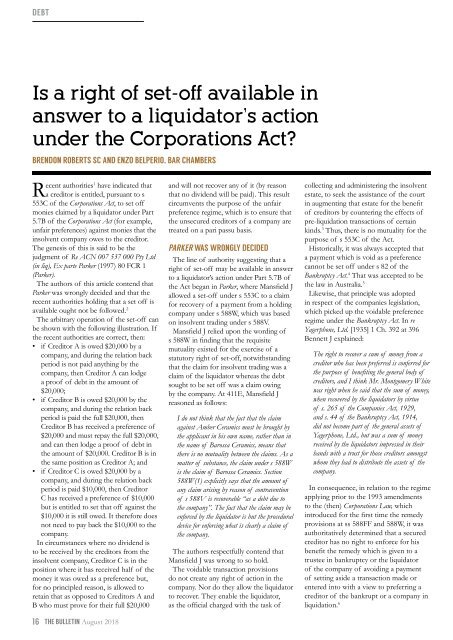The Bulletin August 2018
You also want an ePaper? Increase the reach of your titles
YUMPU automatically turns print PDFs into web optimized ePapers that Google loves.
DEBT<br />
Is a right of set-off available in<br />
answer to a liquidator’s action<br />
under the Corporations Act?<br />
BRENDON ROBERTS SC AND ENZO BELPERIO, BAR CHAMBERS<br />
Recent authorities 1 have indicated that<br />
a creditor is entitled, pursuant to s<br />
553C of the Corporations Act, to set off<br />
monies claimed by a liquidator under Part<br />
5.7B of the Corporations Act (for example,<br />
unfair preferences) against monies that the<br />
insolvent company owes to the creditor.<br />
<strong>The</strong> genesis of this is said to be the<br />
judgment of Re ACN 007 537 000 Pty Ltd<br />
(in liq), Ex parte Parker (1997) 80 FCR 1<br />
(Parker).<br />
<strong>The</strong> authors of this article contend that<br />
Parker was wrongly decided and that the<br />
recent authorities holding that a set off is<br />
available ought not be followed. 2<br />
<strong>The</strong> arbitrary operation of the set-off can<br />
be shown with the following illustration. If<br />
the recent authorities are correct, then:<br />
• if Creditor A is owed $20,000 by a<br />
company, and during the relation back<br />
period is not paid anything by the<br />
company, then Creditor A can lodge<br />
a proof of debt in the amount of<br />
$20,000;<br />
• if Creditor B is owed $20,000 by the<br />
company, and during the relation back<br />
period is paid the full $20,000, then<br />
Creditor B has received a preference of<br />
$20,000 and must repay the full $20,000,<br />
and can then lodge a proof of debt in<br />
the amount of $20,000. Creditor B is in<br />
the same position as Creditor A; and<br />
• if Creditor C is owed $20,000 by a<br />
company, and during the relation back<br />
period is paid $10,000, then Creditor<br />
C has received a preference of $10,000<br />
but is entitled to set that off against the<br />
$10,000 it is still owed. It therefore does<br />
not need to pay back the $10,000 to the<br />
company.<br />
In circumstances where no dividend is<br />
to be received by the creditors from the<br />
insolvent company, Creditor C is in the<br />
position where it has received half of the<br />
money it was owed as a preference but,<br />
for no principled reason, is allowed to<br />
retain that as opposed to Creditors A and<br />
B who must prove for their full $20,000<br />
and will not recover any of it (by reason<br />
that no dividend will be paid). This result<br />
circumvents the purpose of the unfair<br />
preference regime, which is to ensure that<br />
the unsecured creditors of a company are<br />
treated on a pari passu basis.<br />
PARKER WAS WRONGLY DECIDED<br />
<strong>The</strong> line of authority suggesting that a<br />
right of set-off may be available in answer<br />
to a liquidator’s action under Part 5.7B of<br />
the Act began in Parker, where Mansfield J<br />
allowed a set-off under s 553C to a claim<br />
for recovery of a payment from a holding<br />
company under s 588W, which was based<br />
on insolvent trading under s 588V.<br />
Mansfield J relied upon the wording of<br />
s 588W in finding that the requisite<br />
mutuality existed for the exercise of a<br />
statutory right of set-off, notwithstanding<br />
that the claim for insolvent trading was a<br />
claim of the liquidator whereas the debt<br />
sought to be set off was a claim owing<br />
by the company. At 411E, Mansfield J<br />
reasoned as follows:<br />
I do not think that the fact that the claim<br />
against Amber Ceramics must be brought by<br />
the applicant in his own name, rather than in<br />
the name of Barossa Ceramics, means that<br />
there is no mutuality between the claims. As a<br />
matter of substance, the claim under s 588W<br />
is the claim of Barossa Ceramics. Section<br />
588W(1) explicitly says that the amount of<br />
any claim arising by reason of contravention<br />
of s 588V is recoverable “as a debt due to<br />
the company”. <strong>The</strong> fact that the claim may be<br />
enforced by the liquidator is but the procedural<br />
device for enforcing what is clearly a claim of<br />
the company.<br />
<strong>The</strong> authors respectfully contend that<br />
Mansfield J was wrong to so hold.<br />
<strong>The</strong> voidable transaction provisions<br />
do not create any right of action in the<br />
company. Nor do they allow the liquidator<br />
to recover. <strong>The</strong>y enable the liquidator,<br />
as the official charged with the task of<br />
collecting and administering the insolvent<br />
estate, to seek the assistance of the court<br />
in augmenting that estate for the benefit<br />
of creditors by countering the effects of<br />
pre-liquidation transactions of certain<br />
kinds. 3 Thus, there is no mutuality for the<br />
purpose of s 553C of the Act.<br />
Historically, it was always accepted that<br />
a payment which is void as a preference<br />
cannot be set off under s 82 of the<br />
Bankruptcy Act. 4 That was accepted to be<br />
the law in Australia. 5<br />
Likewise, that principle was adopted<br />
in respect of the companies legislation,<br />
which picked up the voidable preference<br />
regime under the Bankruptcy Act. In re<br />
Yagerphone, Ltd. [1935] 1 Ch. 392 at 396<br />
Bennett J explained:<br />
<strong>The</strong> right to recover a sum of money from a<br />
creditor who has been preferred is conferred for<br />
the purpose of benefiting the general body of<br />
creditors, and I think Mr. Montgomery White<br />
was right when he said that the sum of money,<br />
when recovered by the liquidators by virtue<br />
of s. 265 of the Companies Act, 1929,<br />
and s. 44 of the Bankruptcy Act, 1914,<br />
did not become part of the general assets of<br />
Yagerphone, Ltd., but was a sum of money<br />
received by the liquidators impressed in their<br />
hands with a trust for those creditors amongst<br />
whom they had to distribute the assets of the<br />
company.<br />
In consequence, in relation to the regime<br />
applying prior to the 1993 amendments<br />
to the (then) Corporations Law, which<br />
introduced for the first time the remedy<br />
provisions at ss 588FF and 588W, it was<br />
authoritatively determined that a secured<br />
creditor has no right to enforce for his<br />
benefit the remedy which is given to a<br />
trustee in bankruptcy or the liquidator<br />
of the company of avoiding a payment<br />
of setting aside a transaction made or<br />
entered into with a view to preferring a<br />
creditor of the bankrupt or a company in<br />
liquidation. 6<br />
16<br />
THE BULLETIN <strong>August</strong> <strong>2018</strong>


















